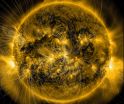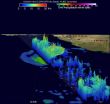(Press-News.org) Our sun is a volatile star: explosions of light, energy and solar materials regularly dot its surface. Sometimes an eruption is so large it hurls magnetized material into space, sending out clouds that can pass by Earth's own magnetic fields, where the interactions can affect electronics on satellites, GPS communications or even utility grids on the ground.
The clouds can be large or small. They can be relatively slow or as fast as 3,000 miles per second, but only one component has a strong effect on how much a CME will arrange the magnetic fields in near-Earth space. If they are aligned in the same direction as Earth's -- that is, pointing from south to north -- the CME will slide by without much effect. If aligned in the opposite direction, however, Earth's magnetic fields can be completely rearranged. Indeed, it has happened that giant, fast moving CMEs have had little effect at Earth, while small ones have caused huge space weather storms, dependent on that one factor of where the magnetic fields point.
But right now we don't have much advance notice of how a CME's magnetic fields are arranged. We can only measure the fields as the CME passes over satellites close to Earth.
"What we have now is effectively only a 30 to 60 minute heads up of a CME's configuration before it hits Earth's magnetosphere," said Neel Savani, a space scientist at NASA's Goddard Space Flight Center in Greenbelt, Maryland. "We don't have a real time method for measuring or modeling this magnetic field more than an hour before a space weather impact."
Savani described a new model to measure the magnetic field configuration significantly further ahead of time in a paper appearing in Space Weather on June 9, 2015. The model is now undergoing testing, but if it's robust, then scientists might finally have a tool to predict a CME's magnetic configuration from afar. And that means forecasters could give utility grid and satellite operators a full 24-hour advance warning to protect their systems -- crucial time to protect their assets.
While we have no tools that can observe the magnetic configuration of a CME directly as it is traveling toward us, Savani made use of NASA's Solar Dynamics Observatory to observe the magnetic fields of the initial eruption on the sun.
In the past, using such data to predict which direction the CME's magnetic fields point has not been very successful. However, Savani realized that earlier attempts simplified the eruptions too much, assuming they came from a single active region -- the magnetically complex spots on the sun that often give rise to solar eruptions. Savani's new method is able to incorporate the complex reality of CMEs having foot points in more than one active region.
"Once you can successfully measure the initial structure of the CME, the next step is to have a good understanding of how it evolves as it travels," said Savani.
We have no tools to measure the magnetic fields once a CME has moved away from the sun, but scientists do have ways of watching how the clouds expand, twist and grow as they race into space. Both NASA's Solar Terrestrial Relations Observatory, or STEREO, and the joint ESA/NASA Solar and Heliospheric Observatory, or SOHO, provide these observations using coronagraphs, which can focus in on the CME's progress by blocking the bright light of the sun.
By watching how the CME moves and changes in these coronagraphs, Savani's model tracks how the initial eruption evolves over time. Ultimately, the model can describe how the CME will be configured as it approaches Earth, and even which parts of the CME will have magnetic fields pointed in which direction.
So far Savani has tested his modeling method on eight different CMEs to show that his model's predictions corresponded with what actually happened. He will test even more examples to make sure the model is truly robust. If perfected, such models can be used by the Space Weather Prediction Center at the US National Oceanic and Atmospheric Association to provide alerts and forecasts to industries that require space weather forecasts, such as the military, the airlines and utility companies. But it's NASA's responsibility - as the research arm of the nation's space weather effort - to make sure a model is reliable enough for regular operational use. So Savani is working with the Community Coordinated Modeling Center at NASA Goddard to test his model.
"We'll test the model against a variety of historical events," said Antti Pulkkinen, director of the Space Weather Research Center at NASA Goddard. "We'll also see how well it works on any events we witness over the next year. In the end we'll be able to provide concrete information about how reliable a prediction tool it is."
Savani will also work to improve the user interface of his model. The goal is to create an easy-to-use application with standardized input and reliable output. Time will tell if Savani's model can help with characterization of CMEs, but if it works, scientists will have an advanced new tool to protect our home planet from the effects of space weather.
INFORMATION:
For more information about the Solar Dynamics Observatory, visit: http://www.nasa.gov/sdo
Researchers at the University of Pennsylvania have found a three to five percent reduction in the probability of criminal recidivism among a sample of juveniles arrested for felony drug offenses, some of whom were processed as adults due to their age at the time of their arrests.
In a study published in the Journal of Research in Crime and Delinquency, Charles Loeffler, an assistant professor of criminology in the School of Arts & Sciences and Ben Grunwald, a doctoral candidate in the criminology department, analyzed the effect of processing juveniles as adults using ...
For engine designers in the digital age, time is money. And that time is measured in computer cycles.
Researchers at the U.S. Department of Energy's Argonne National Laboratory are partnering with Convergent Science, Inc. (CSI), to speed up a key piece of modeling and simulation software to ensure those cycles are used as effectively as possible, reducing product development time and resulting in better engines and savings for consumers. The scale of the speed gains were recently demonstrated when researchers ran the largest engine simulation to date on more than 4,000 ...
Irvine, Calif., June 9 -- Brain inflammation caused by chronic nerve pain alters activity in regions that regulate mood and motivation, suggesting for the first time that a direct biophysical link exists between long-term pain and the depression, anxiety and substance abuse seen in more than half of these patients, UC Irvine and UCLA researchers report.
This breakthrough finding also points to new approaches for treating chronic pain, which is second only to bipolar disorder among illness-related causes of suicide. About a quarter of Americans suffer from chronic pain, ...
MAYWOOD, Ill. -- Brain lesions in children can be especially challenging to diagnose, according to a report in the journal Frontiers in Neurology by a multidisciplinary team of Loyola University Medical Center physicians.
Lesions include tumors, abnormal blood vessel formations and abscesses and inflammation due to infections.
In the pediatric population, such lesions 'can have a large variety of underlying etiologies (causes), which can be challenging to differentiate on neuroimaging,' lead author Marisa McGinley, M.D., and colleagues report.
The Loyola physicians ...
Promotion of handwashing with soap and weekly nail clipping are both successful strategies to decrease intestinal parasite re-infection rates in school aged Ethiopian children, according to a study published by Mahmud Abdulkader Mahmud and colleagues from Mekelle University, Ethiopia, in this week's PLOS Medicine.
The researchers reached these conclusions by conducting a cluster randomized controlled trial in which 367 parasite-negative school-aged children in Northern Ethiopia were randomly assigned to either the handwashing intervention, the nail clipping intervention, ...
Tropical cyclones are not too common in the Arabian Sea, but tropical cyclone 01A, now renamed Ashobaa, formed this week. NASA/JAXA's Global Precipitation Measurement or GPM core satellite flew over Ashobaa and gathered data that provided a 3-D look at the rainfall in the storm.
The GPM core observatory satellite flew over Ashobaa on the morning of June 8 at 0811 UTC (4:11 a.m. EDT). Tropical cyclone Ashobaa had sustained wind speeds of about 40 knots (46 mph) when the satellite passed overhead.
On June 9 at 0900 UTC (5 a.m. EDT), tropical cyclone Ashobaa had maximum ...
MADISON, Wis. -- Scientists have prior evidence that the hormone estrogen is a major driver in the growth of cervical cancer, but a new study examining genetic profiles of 128 clinical cases reached a surprising conclusion -- estrogen receptors all but vanish in cervical cancer tumors.
This counterintuitive finding, reported June 8 in the online Proceedings of the National Academy of Sciences, further bolsters the understanding of cervical cancer's progression and offers valuable new targets to fight the disease.
Lead author Johan den Boon, associate scientist with ...
The economic impact of the Energy Department's National Renewable Energy Laboratory (NREL) was $872.3 million nationwide in fiscal year 2014, according to a study by the University of Colorado Boulder's Leeds School of Business.
The study estimates NREL's impact to Colorado's economy totaled $701 million, a decline of 1.6 percent from the prior year. The slight year-over-year drop was largely attributed to a decline in major construction spending that came as NREL completed the planned build-out of its sustainable campus.
Jefferson County, where the largest concentration ...
Two of our nation's most advanced wind energy research and test facilities have joined forces to help the wind energy industry improve the performance of wind turbine drivetrains and better understand how the turbines can integrate more effectively with the electrical grid.
Through a Cooperative Research and Development Agreement (CRADA), the Energy Department's National Renewable Energy Laboratory (NREL) and Clemson University will partner to share resources and capabilities in the operation and development of testing facilities. The CRADA also includes the exchange ...
DOWNERS GROVE, Ill. - June 9, 2015 - The percentage of U.S. female physician authors of original research in major gastroenterology journals has grown over time, yet the percentage of women in the senior author position remains lower than expected based on the proportion of female gastroenterologists in academia. A look at the evolution of gender in the GI publishing landscape is presented in "Female authorship in major academic gastroenterology journals: a look over 20 years," published in the June issue of GIE: Gastrointestinal Endoscopy, the monthly peer-reviewed scientific ...

